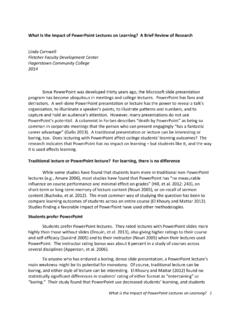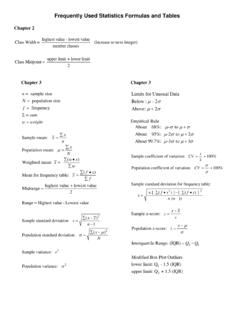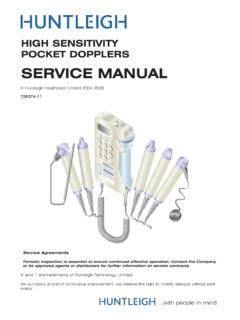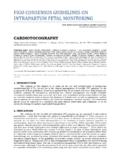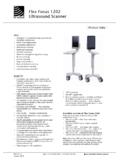Transcription of Echocardiography of Congenital Heart Disease
1 Pediatric EchocardiographySarah Clauss MDChildren s National Medical CenterWashington DCWhat is your career? Echocardiographic Echocardiography and Pediatric of EmbryologyUnderstand Pediatric EchocardiographyCongenital Heart Disease Common lesions Complex lesionsCongenital Heart Defects7-10/1,000 Live BirthsDIAGNOSIS (Balt-Wash)PERCENTV entricular septal defect26%Tetralogy of Fallot9%Atrioventricularseptal defect9%Atrial septaldefect8%Pulmonary valve stenosis7%Coarctation of the Aorta7%Hypoplastic left Heart syndrome6%D-Transposition 5%CHD in Adults30,000 babies born with CHD per year20,000 surgeries for CHD per year85% survive into adulthoodOver million adults with CHDI ncreasing at 5% per year8,500 per year reach adulthoodLess than 10% disabledEvolution of Cardiac SurgeryDiagnosis 1950 s 1960 s 1970 s 1980 s 1990 s 2000 s ASD Rare Repair Repair older child Repair age 4 Repair age 2 Repair age 2-3 Device closure VSD Rare Repair Repair >10 kg or palliate Repair < 1 year or palliate Repair 6 months or prn Repair premature infants PDA Repair Repair Repair Repair Repair TOF Palliate Late Repair in adults Repair after palliation Repair 2-8 months or prn TGA No survivors Rare Survivors Atrial Repair Transitional Decade Arterial Repair Single Ventricle Comfort care Palliate Rare Fontan Fenestrated Fontan Lateral Tunnel Extra-cardiac Fontan HLHS Comfort care Comfort care Surgery in Boston Comfort vs.
2 High risk surgery Surgery & Fetal Diagnosis Embryology 10119 Days: Two endocardial tubes have formed these tubes will fuse to form a common, single primiative Heart tube22 Days: Heart tube begins to beat23 Days: Folding commences30 Days: Primitive circulation 9 weeks (56 Days): All major structures identified(In humans, several months of gestation remain for emergence of HLHS, PS, etc)The Cardiac Crescent and the Tube HeartFrom Heart Development, 1999 Looping and SeptationFrom Heart Development, 199923456 FromDr. do Congenital Heart Defects form?Complex interaction between environmental and genetic etiology Multifactorial 5-8% chance of recurrenceEnvironmental exposures may influence micro-uterine environment and either turn on or off needed protein developmentEcho timeline1793 Italian priest studied bats1845 Austrian scientist Christian DopplerWWII Sonar detected submarines1954 Hertz & Edler (A&B mode echocardiogram)M-mode ultrasound early 1970 s2D echo late 1970 sDoppler Echo 1980 s Pulsed wave doppler Continuous wave doppler Color DopplerPediatric Echo is DifferentAnatomy and physiology over function Segmental approach for complex patients Improved resolution Heart is closer to chest wall Higher frequency transducers TEE rarely necessary for diagnosisInversion of apical and subcostal imagesEcho in CHDD oppler echo Pulsed wave doppler Quantitation of intracardiachemodynamics (Modified BernoulliEquation P= 4 x v22)
3 Valvarregurgitation Intracardiacshunts LVOT/RVOT obstruction Ventricular function Systolic Diastolic (mitral inflow, pulmonary venous inflow)Echo in CHDC ontinuous wave doppler Non-invasive measurements of mean and peak transvalvar gradients Valvar stenosis Prediction of Ventricular Pressure (modified Bernoulli equation) VSD- LV: RV pressure gradient TR/PR RV, PA pressureDopplerSpectral DisplayPulsed Wave (PW)Continuous Wave (CW)Aortic Valve VelocityRV pressure by TR estimationThe pressure in the right ventricle is 55+ 10= 65mmHg. The pressure in the LV is 83 mmHg; we know it from the blood pressurewhich was 83/61. So, it the RV systemic pressure is of the systemic LV pressure. It means RV systemic pressure is elevated. It should normally be 1/3 in CHDC olor doppler Direction of cardiac flow TAPVR vs. LSVC Velocity and Turbulence of cardiac flow Conduit obstruction Identification of intracardiac shunts VSD, PDA, ASD Assessment of Post-op CHD Shunt patency, residual intracardiac much time should you spend trying to obtain doppler of TR when there is a HUGE ventricular septaldefect?
4 If your patient has a single ventricle, if you measure the TR what does that estimate? is it important to doppler a VSD? you see funny blood flow, should you invert your color scale? doctor wants to know if there is pulmonary hypertension in a NICU baby, but there is no TR, is there another way to answer that question?Classification and Terminology of Cardiovascular AnomaliesMorphologic/Segmental approachDefine morphologic not spatial anatomy Which atrium is the Right? Left? Which ventricle is the Right? Left? Which great artery is which?Define segmental anatomy Segments: Atrium, Ventricles, Great Arteries What is the position of each segment relative to each other? Is the RA on the right? Is it connected to the RV? Is it connected to the PA? Is the LA on the left? Is it connected to the LV? Is it connected to the Aorta?Predict the physiology What is the physiology predicted by the segmental connections? Normal? Transposition? Obstructed flow?
5 What is the physiology predicted by flow in the ductus? Across the foramen?Cardiac base-apex axis and orientation in the chestLevocardia Mesocardia DextrocardiaCardiac situs (sidedness)Example: Cardiac sidednessSitus solitus normal cardiac sidedenssSitus ambiguus, right isomerismDifferentiation between the atriaThe morphologic RA has a smooth or sinusal portion, which is found between the interatrial septum and the crista terminalis. It receives the drainage of the superior and inferior venae cavae and the coronary sinus. The trabecular portion is characterized by the presence of pectinate muscles, which are directed from crista terminalis to the base of the right atrial appendage. The RA appendage is wideand its edge is blunt. RA appendage is broad based and triangularly shaped (like Snoopy s nose), with pectinate muscles that extend into the body of the right anatomic LA is totally smoothand lacks pectinate muscles.
6 It receives the drainage of the pulmonary veins, and LA appendage has a narrow baseand fingerlike appearance (like Snoopy s ears) with pectinate muscles confined within the and TV valve characteristicsRight atrium: Limbusof fossa ovalis(limb of oval fossa) Large pyramidal appendage(Snoopy snose) Crista terminalis(terminal crest) Pectinatemuscles Receives venae cavaeand coronary sinus*Tricuspid valve: Low septalannular attachment Septalcordalattachments Triangular orifice (midleafletlevel) Three leaflets and commissures Three papillary muscles Empties into right ventricle LA and MV valve characteristicsLeft atrium: Ostiumsecundum Small fingerlike appendage(Snoopy sear) No crista terminalis No pectinatemuscles Receives pulmonary veins*Mitral valve: High septalannular attachment No septalcordalattachments Elliptical orifice (midleafletlevel) Two leaflets and commissures Two large papillary muscles Empties into left ventricleDifferentiation between the atriaThe only structures that are constant and allow differentiation between the right and left atria are the appendages!
7 The drainage of the systemic and pulmonary veins does not permit the conclusive identification of the atria, as drainage sites are sometimes anomalous. The atrial septum cannot always be used either, because it can have defects or be ventricle:Tricuspid-pulmonary discontinuityMuscular outflow tractSeptal and parietal bandsLarge apical trabeculationsCoarse septal surfaceCrescentic in cross sections*(* variable)Thin free wall (3 5 mm)*Receives tricuspid valve Pulmonary valveempties into main pulmonary arteryVentricles-characteristicsLeft ventricle: Mitral-aortic continuity Muscular-valvularoutflow tract No septalor parietal band Small apical trabeculations Smooth upper septalsurface Circular in cross section*(* variable) Thick free wall (12 15 mm)* Receives mitral valve Aortic valve Empties into ascending aorta Ventricular features (summary) Features of the morphologic RV: Coarse trabeculae with prominent septal band, parietal band, and moderator band.
8 Septophillic attachments of the tricuspid valve (attachments to septum and free wall) Well-developed infundibulum (= conus= cone of muscle beneath the semilunar valve) which results in fibrous dyscontinuity between the tricuspid and semilunar valves Features of the morphologic LV: Smooth septal surface, fine trabeculae Septophobic attachments of the mitral valve (attachments only to free wall) No infundibulum which results in fibrous continuity of the mitral and semilunar valvesAtrioventricular connectionsExamples of : absent right A-V connectionOverriding and straddlingArterial SegmentA-normal, Pa-anterior, leftAo-posterior, rightVentriculoarterialconnection-5 possibleTo Cardiac SegmentsViscera and atria Abdominal situs Systemic and pulmonary venous return Atrial anatomyAtrioventricular canal AV valves and atrioventricular septumVentricles Ventricular anatomy (D-or L-looping) Ventricular size and proportion Ventricular septumConus Ventricular outflow tractsGreat arteries Semilunar valves Great arteriesCommon LesionsASDRVLVLARV DilationRVLVD iastolic Septal FlatteningAtrial Septal DefectsSecundum ASDP rimum ASDS inus Venosus defect Not truly a deficiency of the atrial septum, but the same physiology as an ASDC ommon atriumAtrial Septal ASDPart of spectrum of AV canal defectsDefect is contiguous with AV valvesAssociated with cleft mitral valveSinus Venosus DefectsDeficiency in the wall between the right pulmonary veins and the RAPAPV-DRAINAGE SVC type = RUPV Inferior type = RLPVS inus Venosus ASDASD: Clinical CorrelationUsually diagnosed in childhoodAsymptomaticF>MSystolic ejection murmur and widely split fixed S2 EKG may show RBBB or RVHD evices for ASD ClosureCardio-SEALA mplatzerAmplatzer Occlusion of Atrial Septal DefectClockwise from above.
9 Transcatheter delivery of Amplatzer device, which is positioned across the atrial septal defect Left: Amplatzer device in placeNewborn infant noted to be breathing heavy in New born nurseryChest xray demonstrates increased lung Anomalous Pulmonary Venous Return (TAPVR)I: Supracardiac: common pulmonary vein drains into the right superior vena cava from the left superior vena cava (vertical vein) and the left innominate vein (50%)II: Cardiac: coronary sinus, right atrium (20%)III: Infracardiac: subdiaphragmatic (portal vein, inferior vena cava, ductus venosus) (20%)IV: Mixed: any combination of types I, II, III, the least commonTAPVRP artial Anomalous Pulmonary Venous Return (PAPVR)Right veins (more common):RASVC ( RUPV to the RA or base of the SVC-sinus venosus ASD)IVCLeft veins:Innominate veinCoronary sinus Rarely: SVC, IVC, right atrium, or left subclavian vein Very loud murmur heard prior to hospital dischargeBaby is well, feeding, growing, pink, passed new pulse ox screeningThe Ventricular SeptumAV canal septum (1)Muscular septum including the trabecular portion (2) and the septal band (3)Conalseptum (4)ConoventricularMembranousInletMalalig nmentThe Ventricular SeptumLeft ventricular viewAV canal septum (1)Muscular septum including the trabecular portion (2) and the septal band (3)Conal septum (4)VSD: Clinical CorrelationSize and pulmonary vascular resistance determines clinical presentation Fetal transitionSymptoms are determined by the size of the shunt Size of defect Presence of other anomalies Extracardiac abnormalitiesVSD.
10 Clinical CorrelationSpontaneous resolutionOr Disease Eisenmenger s syndromeAortic regurgitationRestrictive Membranous m/sec87 mm HgNormal RVPU nrestrictive Membranous VSDA trioventricular Canal Defect-CompleteCommon AV Canal (CAVC)Endocardial Cushion Defect (ECD)Atrioventricular Septal Defect (AVSD)Failure of the AV canal to develop properly and form tricuspid, mitral valves and portions of atrial and ventricular septaeDefinitionsSpectrum of defects Incomplete CAVC = lack the VSD component or ASD component Partial CAVC = synonym for incomplete CAVC OR= primum ASD with cleft mitral valve Transitional CAVC = small VSD component Balanced/UnbalancedAtrioventricular Canal Defect PartialAV Septal DefectCompleteAnterior LeafletPosterior LeafletVSDASDB onus are doing the echo on a baby and diagnosis her with an Unbalanced AVC. You are having a hard time imaging the aortic arch. Are you concerned, or do you think to yourself, the arch is always hard to image, these babies have no necks, they can t stand when I put my transducer am sure its fine, I just can t see it right are called to NICU to echo 28 week premature baby, weight is 600 gm, every time you try to image the baby s HR falls and alarms go Ductus ArteriosusPatent Ductus ArteriosusPDA: Clinical CorrelationClosed in 90% of infants by 48 hours of life Prematuring, altitudeAnatomy Derived from the left 6thembryonic archClosure Muscular constriction endothelium thrombosis fibrous strandPhysiology shunting Symptoms proportional to shuntingMurmurEKG Ventricular hypertrophyDoppler of the PDA (L-R shunt)CW doppler tracing (right) seen above the baseline indicating flow toward the probe from the descending aorta through the PDA to the PA.

